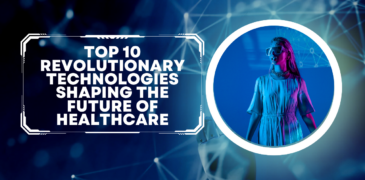The future of healthcare is being reshaped by revolutionary technologies. Promising to transform how we diagnose, treat, and manage health conditions. From artificial intelligence and telemedicine to wearable devices and genomics. These innovations hold the potential to improve patient outcomes, increase access to care, and drive efficiencies throughout the healthcare system. As the world grapples with complex healthcare challenges, exploring the impact of these cutting-edge technologies is essential. In this article, we delve into the transformative potential of these revolutionary technologies and their implications for the future of healthcare delivery, paving the way for a healthier and more connected world.
Here are ten revolutionary technologies poised to shape the future of healthcare:
1. Telemedicine and Virtual Healthcare
Telemedicine and virtual healthcare have emerged as transformative solutions in the modern healthcare landscape. Offering patients convenient access to medical services and professionals remotely. Through telemedicine platforms and virtual consultations, individuals can receive timely medical advice, diagnosis, and treatment from the comfort of their own homes. Eliminating the need for in-person visits and reducing barriers to care.
The adoption of telemedicine has surged, particularly in response to the COVID-19 pandemic. As healthcare providers sought alternative ways to deliver services while minimizing the risk of virus transmission. Beyond offering convenience, telemedicine enhances healthcare accessibility. Especially for individuals in rural or underserved areas, those with mobility limitations, and those requiring ongoing monitoring or follow-up care.
2. Wearable Health Devices and Remote Monitoring
Wearable health devices and remote monitoring technologies represent a paradigm shift in healthcare. It is empowering individuals to proactively manage their health and well-being. These devices, ranging from fitness trackers and smartwatches to medical-grade sensors and monitors. Enable continuous monitoring of vital signs, activity levels, and other health metrics in real-time.
By collecting and analyzing data on various physiological parameters, wearable health devices provide valuable insights into individual health trends and patterns. Facilitating early detection of potential health issues and enabling timely intervention. Moreover, remote monitoring allows healthcare providers to remotely track patients’ health status. Adjust treatment plans as needed and intervene promptly in case of emergencies or deviations from baseline health.
The integration of wearable health devices and remote monitoring technologies into healthcare delivery holds the promise of improving patient outcomes, reducing hospital readmissions, and enhancing the overall quality and efficiency of care.
3. Genomics and Personalized Medicine
Genomics and personalized medicine are revolutionizing healthcare by leveraging individuals’ genetic information to tailor medical treatments and interventions to their unique genetic makeup. Advances in genomic sequencing technologies have made it increasingly feasible and affordable to decode the entire genetic blueprint of an individual. Unlocking valuable insights into their susceptibility to certain diseases, response to medications, and overall health risks.
By analyzing an individual’s genetic profile, healthcare providers can identify genetic variations associated with specific diseases or conditions. Enabling more accurate diagnosis, prognosis, and treatment selection. Personalized medicine allows for targeted therapies and interventions. That are customized to each patient’s genetic characteristics, maximizing efficacy while minimizing adverse effects. This approach has the potential to improve patient outcomes, reduce healthcare costs, and transform the way diseases are prevented, diagnosed, and treated.
4. Robotics and Automation in Surgery
Robotics and automation are reshaping the field of surgery, offering precision, efficiency, and enhanced outcomes for patients. Robotic surgical systems, equipped with advanced imaging and robotic arms controlled by surgeons. Enable minimally invasive procedures with greater dexterity and accuracy than traditional methods.
These technologies enhance the surgeon’s capabilities, allowing for intricate maneuvers in tight spaces and improved visualization of the surgical site. Additionally, robotics enable surgeons to perform procedures with smaller incisions. Leading to reduced trauma, faster recovery times, and decreased risk of complications for patients. Automation in surgery extends beyond robotic systems to include artificial intelligence algorithms that assist in preoperative planning, intraoperative decision-making, and postoperative monitoring.
5. 3D Printing for Medical Applications
3D printing has revolutionized medical applications, enabling the fabrication of patient-specific implants, prosthetics, and anatomical models with unparalleled precision and customization. This technology leverages computer-aided design (CAD) software to create intricate three-dimensional structures layer by layer, using a variety of biocompatible materials.
In healthcare, 3D printing offers a range of benefits, including the ability to produce customized implants tailored to individual patient anatomy. Reducing the risk of complications and improving patient outcomes. Additionally, 3D-printed anatomical models allow surgeons to plan complex procedures, practice surgical techniques, and enhance communication with patients and interdisciplinary teams.
6. Internet of Medical Things (IoMT)
The Internet of Medical Things (IoMT) is a network of interconnected medical devices, sensors, and applications that collect, transmit, and analyze healthcare data in real-time. These devices, ranging from wearable monitors and implantable sensors to medical imaging equipment and smart healthcare infrastructure. It enables remote patient monitoring, personalized treatment, and predictive analytics.
IoMT technologies enhance healthcare delivery by providing continuous, personalized care outside of traditional clinical settings. Empowering patients to actively participate in their own health management. Through real-time data monitoring and analysis, healthcare providers can detect early warning signs of deterioration. Intervene promptly and optimize treatment plans to improve patient outcomes.
7. Blockchain for Healthcare Data Management
Blockchain technology holds immense potential for revolutionizing healthcare data management by providing a secure, transparent, and decentralized platform for storing and sharing sensitive medical information. Unlike traditional centralized databases, blockchain enables immutable and tamper-proof recording of transactions, ensuring data integrity and authenticity.
In healthcare, blockchain facilitates secure storage and efficient exchange of electronic health records (EHRs), medical claims, and other healthcare data among stakeholders. Including patients, healthcare providers, insurers, and researchers. By eliminating the need for intermediaries and central authorities. Blockchain streamlines data access and enhances interoperability while maintaining patient privacy and confidentiality.
8. Electronic Medical Records (EMRs)
Electronic Medical Records (EMRs) digitize and streamline patient health information. It is offering healthcare providers a centralized platform for storing, accessing, and managing medical data. EMRs contain comprehensive patient histories. Including demographics, medical history, medications, allergies, laboratory results, and treatment plans.
By replacing paper-based records with electronic formats, EMRs improve efficiency, accuracy, and accessibility of healthcare information. Enabling quick retrieval and sharing of patient data among authorized healthcare professionals. Moreover, EMRs support clinical decision-making by providing real-time insights into patient health status, facilitating evidence-based care delivery and treatment coordination.
9. Augmented Reality (AR) and Virtual Reality (VR) in healthcare
Augmented Reality (AR) and Virtual Reality (VR) technologies are revolutionizing healthcare by creating immersive and interactive environments for medical training, patient education, and clinical applications. AR overlays digital information onto the user’s real-world environment, while VR immerses users in entirely virtual environments.
In healthcare, AR and VR enable medical professionals to visualize complex anatomical structures, simulate surgical procedures, and practice intricate techniques in a risk-free virtual environment. These technologies enhance medical education, training, and surgical planning, leading to improved proficiency and patient outcomes.
10. Nanotechnology for Drug Delivery and Diagnostics
Nanotechnology offers groundbreaking opportunities in drug delivery and diagnostics by leveraging nanoscale materials and devices to enhance precision, efficacy, and targeted delivery of therapeutics. Nano-sized particles, such as liposomes, dendrimers, and nanoparticles, can encapsulate drugs, protecting them from degradation and enabling controlled release at specific sites in the body.
In drug delivery, nanotechnology allows for the design of novel formulations that improve drug solubility, bioavailability, and pharmacokinetics, leading to enhanced therapeutic outcomes and reduced side effects. Additionally, nanoparticles can be engineered to target specific cells or tissues, maximizing drug delivery to diseased sites while minimizing off-target effects.
In diagnostics, nanotechnology enables the development of sensitive and specific detection methods for diseases, biomarkers, and pathogens. Nanoscale sensors and imaging agents offer unprecedented capabilities for early disease detection, personalized medicine, and real-time monitoring of treatment responses.
Conclusion
In conclusion, the revolutionary technologies shaping the future of healthcare. From genomics and personalized medicine to robotics, AI, and nanotechnology, promise to usher in a new era of precision, accessibility, and patient-centered care. These innovations hold the potential to transform how we prevent, diagnose, and treat diseases, improving patient outcomes. Enhancing efficiency and reducing healthcare disparities. As these technologies continue to evolve and integrate into clinical practice. They have the power to revolutionize healthcare delivery, making it more personalized, efficient, and effective. Embracing these advancements will be key to unlocking the full potential of healthcare innovation and ensuring a healthier future for all.
Read more:







